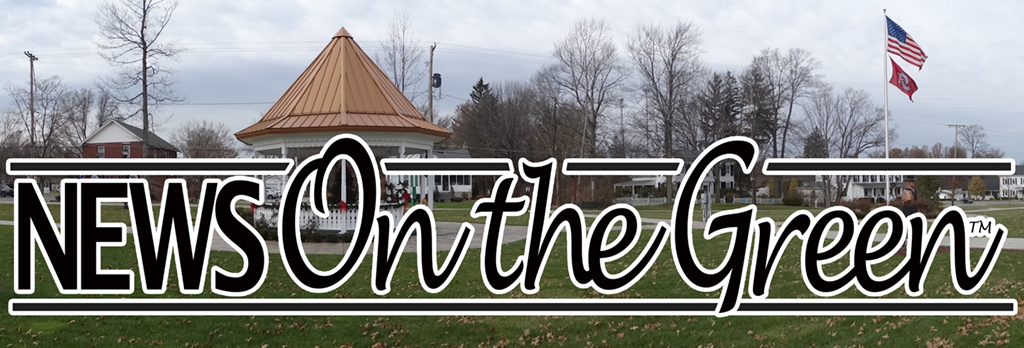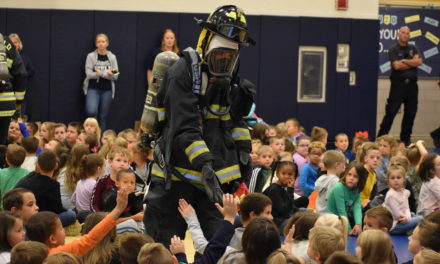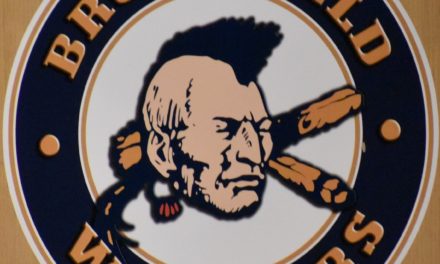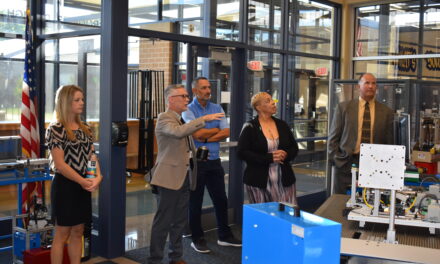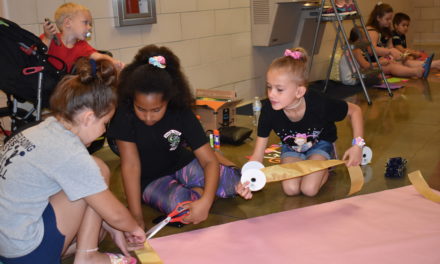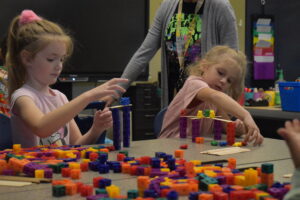
Sadie Smoot, left and Emmalyn Brainard build structures in their kindergarten STEM class.
Editor’s note: STEM, which stands for science, technology, engineering and math, is a popular concept in education circles, and one that Brookfield school Supt. Toby Gibson has embraced since he was the Brookfield Middle School principal. NEWS On the Green attended four STEM classes at different grade levels to try to define what STEM means in Brookfield schools, and how it is applied at different ages.
Colt Shoaff balanced a Popsicle stick on a skinny tower of plastic blocks. When he placed a tiny plastic bear on top of the stick, the weight was too much, and the whole thing toppled.
Colt, wearing a red “Street Fighter” T-shirt, built a second tower to go with the first, straddled the Popsicle stick on each tower, and then added bears. The second tower allowed the bears to stay put, and nothing fell until Colt brought everything down.
While it sounds a lot like Colt was playing, he wasn’t at home or at a friend’s house – he was at school. Colt is a Brookfield Elementary School kindergarten student, and this assignment was part of his weekly STEM class.
At Brookfield, students in every grade are getting a taste of STEM, whether it’s with Megan Totten, who is in her first year at Brookfield teaching grades kindergarten through seven; in the Maker Space; in the Industry 4.0 and robotics lab; in the pre-apprenticeship program; in drone class or in some other format.
Colt and the other kindergartners were asked to build structures, and then balance sticks with bears on top of them. Totten said she wanted the students to learn what kinds of structures worked, and what didn’t, and whether one was good enough or more were better. The blocks were not of uniform size, so the students had to learn which worked best for what they were trying to accomplish. In some cases, they learned from other students who seemed to catch on more quickly.
“It’s neat to see the difference in their structures,” Totten said. “Some can be simple and some can be pretty complex.”
As the class wore on, the students started building houses, roads and elevated pathways.
STEM gets students working with their hands, solving problems and working as part of a team, Totten said. It allows them the time to make mistakes and try things again in a different way.
“The goal is to see that light bulb go on,” Totten said, ”see what they can do and what they can achieve.”
Some of the activities overlap from grade to grade, but variables are added for the older students, Totten said. In assigning this same exercise to first or second graders, the amount of material per student was reduced, whereas the kindergartners had as many blocks, sticks and bears as they wanted, she said.
@@@
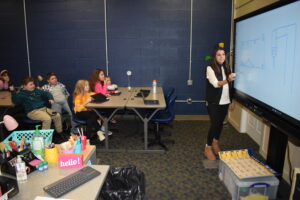
STEM teacher Megan Totten explains how a robot works for her fourth-grade class.
We’re used to having things done for us, Totten told her fourth-grade class. She referenced the video game controllers the kids play with at home. You turn it on, flick the levers and avatars or objects move across the screen.
“When you hit that controller, it does what you want it to do,” she said.
But, why does it work? she asked the students. It works because someone programmed the little computer inside the controller to react to what the kids are doing, and turn that into actions on the screen.
Totten then showed the students a video of a Kuka robot making music on water-filled glasses, and playing table tennis against Timo Boll, a professional. The robot is incredibly fast and efficient. It puts the same amount of pressure on the glasses without breaking them, and easily counters every shot by Boll.
“This robot is not gonna make a mistake unless the person who programmed it made it a mistake,” Totten said.
Totten played another video, this one showing her and fellow Brookfield teacher Josy Kirila at a training program on a Kuka robot. Yes, Brookfield has one.
In this video, the robot picks up a pencil, draws a line, puts the pencil down, picks up a block and drops it at a specified point.
“That took us five days,” Totten said of programming the robot to perform those tasks. It took three hours of programming just to have the robot pick up the pencil, she said.
Toward the end of class, Totten took the students to the high school robotics lab to see the district’s Kuka robot. Unfortunately, it wasn’t working this day, but at least she was able to put into the students’ minds that, when they get to high school, they can program it.
“Every year is a stepping stone to the next,” she said, with the ultimate goal of preparing the students for the high school STEM offerings.
@@@
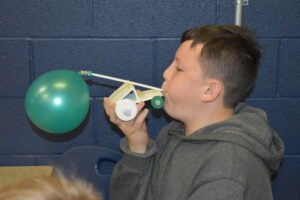
Kyle Fisher blows up the balloon that powers his rocket car in his seventh-grade STEM class.
Students in grades five, six and seven built rocket cars, which are basically cars made out of household items powered by air from balloons.
The fifth-grade students were given specific instructions as to how to make the cars, Totten said. The sixth-graders got less direction, and the seventh-graders were pretty much on their own.
The seventh-grade students collected cotton balls, straws, pieces of poster board, Popsicle sticks, toilet paper tubes, rubber bands and other items from home and brought them to class.
This is not a class where you have to cover your papers. Totten encouraged the students to look up things online, observe what their classmates were doing – and steal the best things.
“I love to see them being able to work on things on their own, without me standing over their shoulder,” Totten said.
Sometimes, personal creativity gets in the way of getting the job done. A group of girls built what looked like a winter parade float on top of Matchbox cars. Nicolai Taafe glued a dinosaur to the top of his car. However, both learned that they couldn’t get their cars to move, likely because they were too heavy.
“What I’m seeing is amazing effort and you’re trying really hard,” Totten told the students. “But, remember that doing it simple doesn’t mean you aren’t working hard.”
Kyle Fisher started with a boat with a foam board body that he had made in another class. He took the mast and sail off and attached wheels made from bottle caps. It took a while to get all the wheels level, and then he had an issue powering the car. He attached the balloon to a straw, and it turned out that the shorter the straw was, the farther the car would go when he let it loose in the hallway.
“Kyle’s car is very simple,” Totten said. “We are realizing that sometimes simpler is more efficient.”
Again, it looks like the students are playing, but they also are learning concepts such as weight distribution, velocity, materials and aerodynamics.
Unlike most other classes, STEM class is not tied to a rigid lesson plan.
“We can do something for a day. We can do something for three weeks,” Totten said. “That’s the beauty of this class – It puts them to the challenge of working hard.”
@@@
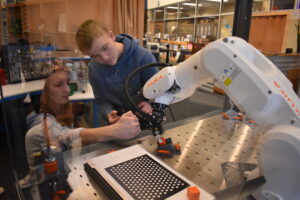
Robotics teacher Josy Kirila and student Josh Schell try to figure out why the school’s Kuka robot is not working properly.
Once students get to the high school, the STEM classes are not just about teaching concepts. They’re also about showing them that the skills they have been learning are transferable to the workplace.
On this day, John Konecheck, community and regulatory affairs manager for Tenaris, a world-wide industrial pipe manufacturer which has a plant in Brookfield, is visiting the Industry 4.0 class, where students learn to build circuits and relays, operate a package sorting facility and perform industrial maintenance tasks. Konecheck has brought virtual reality goggles that give viewers a tour of a Tenaris plant in Bay City, Texas. The plant has a Kuka robot that looks just like Brookfield’s, although it’s many times larger.
“To have that (Kuka robot) in a school is epic,” Konecheck said. “You guys are so lucky to have this. You are gonna have such an advantage when you leave here.”
From this class, students can take state certification tests in electrical systems, pneumatic systems, ethernet communications and a host of other specialties, and earn industry-recognized credentials. The school announced Jan. 9 that Ryland Mihalcin was the first student to earn an industry credential, in basic manufacturing operations from the Smart Automation Certification Alliance. Troy Randall and Jack Nicholas later achieved the same certification.
“Credentials are worth gold in the marketplace,” said Alex Hertzer, assistant director of the Mahoning Valley Manufacturers Coalition, who also was visiting Brookfield schools.
On top of the hard skills students are specifically studying, they also are learning soft skills such as working as a team and solving problems, said Konecheck.
Solving problems is a major subject in Industry 4.0 as some of the machines are made to break down. It’s up to the students to figure out what went wrong and to fix it. Student Justin Budnik noted it took him a week to fix one machine.
In the robotics class, the students learn to program the Kuka robot and a less-sophisticated Pegasus robot, and the language used is different for each one.
Kirila, who teaches Industry 4.0 and Robotics, graduated from Brookfield five years ago, and she said she can’t believe she’s walking into the same school when she comes to work each day. There was no robotics lab, drone class or pre-apprenticeship program when she graduated, she said.
The difference in teaching styles between STEM classes and traditional subject classes means more students are being reached, she said, noting that some of the inattentive geometry students she taught last year are now star students in the Industry 4.0 class.
“This is a way better way for some kids to spend their time,” Kirila said.
Senior Garrick Cottle called his robotics class “really cool” because it engages him differently than typical classroom work. He likes to work with his hands, he said.
“For me, learning is better if I see it than from someone just to tell me how to do it,” Garrick said.
@@@
Gibson is proud of Brookfield’s STEM offerings, but he’s not satisfied with what he and other Brookfield administrators and teachers have accomplished in opening up learning pathways to students. There’s still more to be done, he said.
One goal Gibson has is expanding STEM into STEAM by adding arts programming. The district currently has one art teacher, who works with all grades. He wants to add more art instruction, and is applying for grants that would allow the district to create another pathway to graduation in art and communications, and establish a graphic arts and design program.
“We have talented students in music and the arts,” he said. The district needs to “start promoting that a little bit more.”
Finally, Gibson doesn’t want just to offer STEM to his students – he also wants to offer it to community members. Maybe, someone wants to earn a Microsoft certification or an industry credential through the Industry 4.0 lab, he said.
“There may be somebody out there who wants a job change in the community,” he said. “Give them the opportunity to come in and start that course work and put something on a resume.”
To that end, the school district has started a series of weekend events called Brookfield Builds in which students and parents can join for an activity overseen by Brookfield school personnel. The first one was held Jan. 21 when art teacher Linda Bain helped participants make cartoon thumbprint picture books. Additional programs, which will take place in the Maker Space, robotics lab and other areas of the school, will be announced on the district’s Facebook page.

